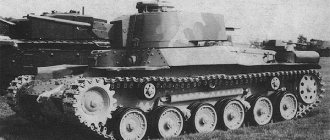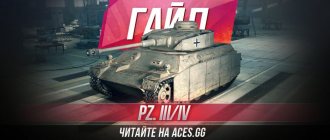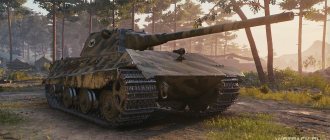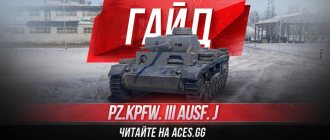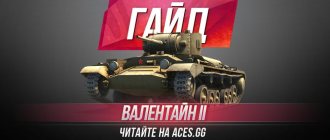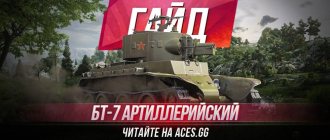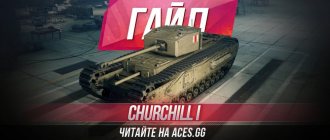Weapon type
| Type 3 Chi-Nu | |
| Chi-nu Type 3 at the JGSDF Gunnery School in Tsuchiura, Japan | |
| Place of origin | Empire of Japan |
| Production history | |
| Designed by | 1943 |
| Produced | 1944–1945 |
| No. built | 144–166 [1] [2] |
| Characteristics | |
| Weight | 19 tons (21 tons) [3] |
| Length | 5.64 m (18 ft 6 in) |
| Width | 2.41 m (7 ft 11 in) |
| Height | 2.68 m (8 ft 10 in) |
| Crew | 5 |
| Armor | 20–50 mm [4] |
| Main weapons | 75 mm tank gun Type 3 (L/38) [4] (Armor penetration: 90 mm at 100 m, 65 mm at 1000 m) |
| Secondary weapons | 1 x 7.7 mm Type 97 machine gun [4] |
| Engine | Mitsubishi Type 100 21.7 L V-12 diesel 240 hp (179 kW) at 2000 rpm (12.63 hp/t) |
| Suspense | Bell |
| Operating range | 210 km (130 mi) |
| Maximum speed | 39 km/h (24 mph) |
Type 3 Medium Tank Chi-Nu
(三式中戦車チヌ, San-shiki chu-sensha Chi-Nu) ("Imperial Year 2603 Medium Tank Model 10") was a medium tank of the Imperial Japanese Army in World War II. Like the Type 1 Chi-He, this tank was an improved version of the Type 97 Chi-Ha. It included the Type 3 75 mm tank gun, one of the largest Japanese tank guns during the war.
The Chi-nu did not participate in combat during the war. All units produced were retained to defend the Japanese homeland in anticipation of the Allied invasion.
Type 3 Chi-Nu tank production line, 1945
History and development[edit]
At the outbreak of the Pacific War, the Type 97 Chi-Ha medium tank and Type 95 Ha-Go light tank designs formed the mainstay of the armored units of the Imperial Japanese Army. As the war progressed, these tanks began to face serious problems posed by Allied tanks. In the Burma and Philippines campaigns, the firepower of the Type 97's 57 mm cannon proved insufficient against Allied tanks. Therefore, the Imperial Japanese Army developed the 47 mm Type 1 tank gun, which used a lighter high-explosive fragmentation round with greater armor penetration. This gun was installed on the Type 97 Shinhoto Chi-Ha and Type 1 Chi-He medium tanks. [5]
In the later stages of the war, large numbers of American M4 Sherman tanks arrived on the front lines and increased pressure on Japanese tank forces. The Imperial General Staff (大本営Daihon'ei) decided to develop a new medium tank to counter the enemy threat, as well as to replace the Type 97.[6]
The Army Technical Bureau was working on the Type 4 Chi-To medium tank as a counterweight to the M4 Sherman, but the program was plagued by problems and delays. As a result, a spare tank was required. The Type 3 Chi-Nu medium tank was designed to counter the M4 Sherman. [7] Work on the Type 3 Chi-Nu began in May 1943 and was completed by October. The low priority given to tank production by 1943 meant that the Type 3 did not actually go into production until 1944, by which time raw materials were in very short supply and much of Japan's industrial infrastructure had been destroyed by American strategic bombing. [8]
Side view of the Type 3 Chi-Nu
By the end of the war, between 144 and 166 units had been produced. [1] [2] The Type 3 Chi-Nu was the last tank to be fielded by the Imperial Japanese Forces and was still in production at the end of the war. [7]
“Chi-Nu” - a tank that was late for the war
During World War II, the Japanese came closer than ever to possessing the entire Pacific region.
And they managed to do this without possessing powerful armored vehicles. However, most military operations took place in difficult jungles and islands, and neither China nor the European colonial forces had significant tank forces. Subsequently, the course of the war forced the Japanese to develop more powerful armored vehicles. And it is significant that some of these machines did not have time to fight, although they were put into production. One of the representatives of these “losers” is the Type 3 “Chi-Nu” medium tank.
- History of creation
- Design
- Applications and modifications
- Performance characteristics
- Video
Since the Type 97 Chi-Ha is at the third level, the promotion to the top happens quite quickly. But this does not make the tank a piece of candy. Let's take a closer look at its characteristics.
We have a choice of four weapons, but our freedom is rather elusive. We can install three pre-top guns on a stock turret, but in order to get a top-end version, we need to research the corresponding turret. Pre-top guns have fairly good accuracy and aim, but suffer from low penetration. The top version offers us excellent penetration (which allows us to hit all enemies on the level), a good alpha, but at the same time sacrifices accuracy and convergence relative to its younger brothers.
The Type 97 Chi-Ha has two turrets to choose from. The stock one can accommodate all the guns except the top model. The difference in characteristics between these two is small. The top version will give us 10 m more visibility and the ability to install a top gun. Otherwise, they are identical.
The range of radio communication between the top and stock samples is 200 meters, which is quite a lot, especially on such a scale: from 350 to 550 meters. I advise you to research the last radio station for this tank so as not to feel the discomfort of incompletely highlighting enemies on the minimap.
The Type 97 Chi-Ha has three engines in the research branch, which are quite different. If the stock version gives 170 hp, then the top version gives as much as 240 hp. A very serious increase in power density. But at the same time, the dynamics of the tank leave much to be desired. On the battlefield, the Type 97 Chi-Ha behaves rather slowly, as if it had just been woken up and forced to attack. He does this, apparently reluctantly.
Design[edit]
Armor and protection [edit]
The Type 3 Chi-Nu retained the same chassis and suspension as the Type 1 Chi-He, but added an enlarged turret ring for a new large hex gun turret with a commander's cupola. [3] [9] This was the last design based directly on the Type 97's origins. [10] The thickest armor was 50 mm on the front of the hull; it also had 25 mm on the turret, 25 mm on the sides and 20 mm on the stern. [4]
Type 3 Chi-Nu during assembly, showing its transmission and partially installed controls
Weapons [edit]
The Type 3 Chi-Nu's main armament was the Type 3 75 mm tank gun. The gun could be at an angle from -10 to +25 degrees. Firing the projectile at a muzzle velocity of 680 m/s (2,200 ft/s) gave armor penetration of 90 mm (3.5 in) at 100 m (110 yd) and 65 mm (2.6 in) at 1,000 m (1,100 yd). ). [11] [12] Additional armament was a Type 97 machine gun. [4]
Mobility[edit]
The Chi-Nu had the same engine as the Type 1 Chi-He, producing 240 hp. and a maximum speed of 39 km/h. [2] [13]
Equipment for Type 3 Chi-Nu Kai
When considering the advantages and disadvantages of this unit, it is immediately clear that we have a number of weaknesses that definitely need to be corrected, and it wouldn’t hurt to improve some of the strengths either. Thus, on the Chi-Nu Kai tank equipment
It’s better to put the following: 1. – with good one-time damage, you need to make sure that you can deal it as often as possible, besides, this Japanese’s DPM is not the best. 2. – the list of disadvantages includes a mediocre aiming time, so let’s fix it to make shooting more comfortable. 3. – our viewing range is good, but it’s still far from the maximum, and in battles against the seventh levels, strengthening this parameter will be especially useful.
Of course, someone may want to neglect increasing the vehicle’s visual abilities for the sake of achieving greater damage per minute and shooting comfort, in which case the latter option can be replaced with .
Service record[edit]
Type 3 Chi-Nu in 1945
Type 3 Chi-Nu, captured by the Americans after the surrender
The Type 3 Chi-Nu was allocated to the Japanese home islands to defend against the anticipated Allied invasion. They were to be part of a "Mobile Strike Force" that would be used to counter-attack the Allied invasion. [14] Because Japan's surrender occurred before the invasion, the Type 3 was never used in combat. [15] By the end of the war, the 4th Armored Division, based at Fukuoka on the island of Kyushu, had a "significant" number of Type 3 Chi-Nu tanks in production. [16]
Type 98 main battle tank (WZ-123)
Modifications:
• “Type 99” (ZTZ-99) (production tank with reinforced armor; 2000)
Vehicles based on the Type 98: no
The prototype of the newest Chinese third-generation tank “Type 98” (factory index WZ-123 or ZTZ-98 ) was first publicly shown on October 1, 1999 during a military parade in Beijing on Tiananmen Square, dedicated to the 50th anniversary of the founding of the People's Republic of China. Of course, the appearance of such a machine caused a general sensation. Quite unexpectedly, the Chinese demonstrated that they have a tank that is approaching in its combat capabilities the main battle tanks of other countries. of Type 98 and Type 96 tanks rode in the general formation at the parade , which allowed some would-be observers to identify them as experienced Type 90-II/90-IIM , since, allegedly, some tanks had two, and the other four exhaust pipes (of course, the latter applied to the Type 96/88C , in which two exhaust pipes exit to the starboard side).
Undoubtedly, the Type 98 was a technical breakthrough for the Chinese military industry. Development of the third generation tank concept began in China in the 1970s. Its design solutions were tested on experimental models WZ-1224 and WZ-1226 , created in the 1980s, as well as export samples “Type 90-II” / MBT-2000 , and by the end of the 1990s, China finally created its own promising tank. The main developers of the machine were the North China Mechanical Engineering Research Institute No. 201 (NEVORI, Beijing) and the First Machinery Manufacturing Company FIRMACO (formerly Plant No. 617 in Baotou, Inner Mongolia). When designing the tank, its concept changed several times. Options were offered with a 120-mm or 105-mm Western-style cannon, with or without an automatic loader, with gas turbine or diesel engines. By 1984, a compromise was found and it was decided to use the concept of the Soviet T-72 , repeating its layout and some design solutions.
The hull of the new prototype was created anew, and its nose actually repeated the design of the T-72M . The same thing happened with the chassis - many of its elements were copied from the T-72M (more precisely, from the Type 90-II ). It also inherited weapons, a mechanized ammunition rack with an automatic loader, and much more. The modular armor of the turret is also similar to that of the Type 90-II (with the ability to install mounted dynamic protection). The tower has a welded structure made of armor plates of different thicknesses, located at rational angles of inclination and is equipped with a large aft niche.
An exceptional feature of the Type 98 JD-3 laser active protection system for the tank . It consists of a laser warning system LRW (laser warning receiver; mushroom-shaped sensor behind the commander's hatch) and a quantum generator LSDW (laser self-defence weapon; box-shaped housing behind the gunner's hatch). When receiving a signal that a tank is being irradiated by an enemy laser beam, the warning system generates a signal to turn the turret towards the detected source, then a low-power laser beam is turned on, determining the exact location of the target, after which the beam power instantly increases to a critical level and disables optical means or organs of vision of the enemy operator. It is known that the Chinese side previously demonstrated portable versions of such laser weapons. For example, in 1995 at an exhibition in Manila. There it was designated as ZM-87 (supposedly can damage the human eye at a distance of up to 10 km). Judging by the way the tank's laser system was aimed in a vertical plane, there is a possibility that it could also be used as a means of destroying low-flying helicopters.
The main armament of the tank, a 125-mm smoothbore gun, is an unlicensed copy of the Russian 2A46 , and in fact its Chinese version, redesigned to suit local technologies. The gun barrel is equipped with a thermal insulating casing. The hydromechanical autoloader of the carousel type for 22 shots was also copied from the Russian one (previously it was mastered in the production of the Type 85-IIM , Type 96 and Type 90-II ). When using AZ, the rate of fire reaches 8 rds/min, without it - 2 rds/min. The total ammunition load is 41 rounds of separate cartridge loading with armor-piercing sub-caliber projectiles with a separating pan, cumulative and high-explosive fragmentation. It has been reported that China has the ability to produce armor-piercing sub-caliber projectiles with a depleted uranium core in cooperation with Israel. Most likely, such shells will also be in service with Type 98 . It was also reported about China's purchase of Russian laser-guided 9M119 "Reflex" ATGMs, which China intends to produce under license also for arming Type 98 .
The developed fire control system of the Type 98 includes a gunner's sight with a built-in laser rangefinder and a thermal imaging channel, a commander's panoramic combined sight (the image from the thermal imager is displayed on the displays of both with a magnification of x11.4 or x5), a 2-plane weapon stabilizer, digital ballistic computer and a set of sensors. The control system is made by analogy with the Type 90-IIM/Al Khalid using Western technologies.
As auxiliary weapons, the tank is equipped with two machine guns: a coaxial 7.62 mm Type 86 (to the right of the gun) with 2000 rounds of ammunition and an anti-aircraft 12.7 mm W-85 (in front of the commander’s hatch) with 300 rounds of ammunition. The coaxial machine gun is fired using an electric trigger at a range of up to 1000 meters. A manually controlled turret anti-aircraft machine gun mount (designated “QJC-88” ) provides firing only in the front sector at a range of up to 1600 meters against ground targets and up to 1500 m against air targets. Its pointing angles in the vertical plane range from -4 to +75 degrees. In addition, there are two 5-barrel blocks of Type 84 installed on the sides of the turret.
Water-cooled turbocharged diesel engine with 1200 hp power. is derived from the German WD396 . It is interlocked with the transmission into a single power unit, which can be replaced in the field in 30...40 minutes. The power plant is similar to the Type 90-II , but is significantly reconfigured, and therefore the height of the MTO is reduced compared to the Type 90-II , on which a similar engine was installed. The simple mechanical transmission with manual control is almost entirely borrowed from the T-72M . When using OPVT, the tank can overcome water obstacles up to 5 m deep directly along the bottom. In the stowed position, the OPVT equipment is attached to the aft part of the tower niche, as well as partially inside it. The chassis (on board) includes 6 track rollers and 4 support rollers, gable rollers have rubber tires, torsion bar suspension with hydraulic shock absorbers on the first two and last suspension units, a rear drive wheel (lantern engagement). The caterpillar is equipped with a rubber-metal hinge. The chassis is covered with removable rubber-fabric or metal screens.
At the 1999 parade, China demonstrated only 18 Type 98 , but Western analysts immediately assumed mass production of these vehicles. However, in fact, China did not intend to rearm its entire army with such machines due to the high cost and technical complexity. They were intended primarily only for elite units. Later it turned out that the “Type 98” was just a prototype, and a more advanced machine, which appeared under the designation “Type 99,” .
| MAIN CHARACTERISTICS | |
| Combat weight, kg | 48 000 |
| Crew, people | 3 |
| Main dimensions, mm: | |
| — Length with gun forward | 10920 |
| - Width | 3372 |
| — Height to the roof of the tower | 2200 |
| — Clearance | 470 |
| — Base x Track | 5160 x no data |
| Average specific ground pressure, kg/sq.cm | 0,9 |
| Armament (ammunition, shots): | |
| — 125 mm smoothbore 2A46 — 7.62 mm Type 86 machine gun — 12.7 mm W-85 anti-aircraft machine gun | 1 (22+19) 1 (2 000) 1 (300) |
| Vertical guidance angles, degrees. | -6…+14 |
| Sights | combined commander and gunner; thermal imager |
| Laser rangefinder | built-in |
| Weapon stabilizer | two-plane |
| Ballistic computer | digital |
| Loading mechanism | yes (AZ type) |
| Active protection means | JD-3 (LRW/LSDW) |
| Means for setting up smoke curtains | 2x5 grenade launchers |
| Engine type and brand | diesel MTU WD396 8-cylinder |
| Maximum power, hp | 1200 |
| Specific power, hp/t | 25 |
| Fuel tank capacity, l | no data |
| Transmission | mechanical |
| Maximum speed, km/h: | 65..75 |
| Cruising range, km | 450…600 |
| Obstacles to be overcome: | |
| — rise, hail. | 30 |
| - roll, hail. | 25…29 |
| - ditch, m | 2,7 |
| — wall, m | 0,85 |
| - ford, m | 1.4 (with OPVT - 5) |
| Booking | combined |
Photo detailing
| Laser installation LSDW and sensor LRW of the active protection system of the tank | Combined gunner's sight with laser rangefinder and thermal imager | ||
| Commander's panoramic combined sight with thermal imager display | |||
| — | — | ||
| Elements of the automatic loader (a copy of the AZ of the Russian T-72 tank) and the breech of the 125-mm cannon of the Type 98 tank | |||
| Anti-aircraft machine gun mount "QJC-88" with a 12.7 mm W-85 machine gun | |||
Photo gallery
| — |
Sources used: “Military equipment and weapons of China. Tanks." L. Karyakin, V. Moiseev; Chinese Defense Today; "ZTZ-98 Main Battle Tank"
Join our group “Courage 2004”
Share on social networks:
Notes[edit]
- ^ a b Zaloga 2007, p. 22.
- ^ abc Imperial Japanese Army Taki: Type 3 "Chi-Nu"
- ^ a b Hara 1972, p. 18.
- ^ abcde Tomczyk 2005, page 14.
- Zaloga 2007, pp. 19, 20.
- Zaloga 2007, pp. 20, 21.
- ^ ab Imperial Japanese Army Taki: "Tanks after Chi-Ha" Retrieved May 2, 2016
- Tomczyk 2005, p. 3.
- Tomczyk 2005, pp. 3, 32.
- Zaloga 2007, pp. 17, 21.
- Tomczyk 2005, pp. 3, 5.
- Imperial Japanese Army Taki's: "Tank Guns" Type 3 75mm Tank Gun
- Imperial Japanese Army Taki's: Type 1 "Chi-On"
- Rottman & Takizawa 2008, p. 16.
- Zaloga 2007, pp. 21, 22.
- Tomczyk 2005, p. 15.
- Tomczyk 2005, pp. 38-42.
Use in combat
In realistic and simulation battles, the ideal tactic for this tank is to flank. The main opponents are T-34 of various modifications, KV-1, American M4A1 Sherman, Cromwell V and Churchill III. All medium and light tanks that the Chi-Nu hits are easily destroyed by a Type 1 chamber shell in the front of the turret, and almost all of them in the hull's VLD. Heavy tanks, such as the KV-1, are best outflanked from the flanks and rear. The vehicle's mobility allows you to be in the right position and take the enemy by surprise at the beginning of the battle.
For arcade mode, another tactic is suitable - covering your allies from the rear. Being in the rear of your team, you can hit enemy tanks in vulnerable spots from a long distance thanks to good optics. When playing on this tank, you cannot allow the enemy to discover you. For camouflage, you need to use various shelters, terrain folds, camouflage and, if possible, camouflage decorators.
Advantages and disadvantages
Advantages:
- Powerful main weapon
- Vertical aiming angles
- Fast recharge
- 5 crew members
- Anti-aircraft machine gun
- Weak armor
- Low turret traverse speed
- Average mobility
- Non-retractable ammunition from the turret
Links[edit]
- Foss, Christopher (2003). The Great Book of Tanks: The World's Most Important Tanks from World War I to the Present
. Zenit Press. ISBN 0-7603-1475-6. - Foss, Christopher (2003). Tanks: 500. Crestline. ISBN 0-7603-1500-0.
- Hara, Tomio (1972). Japanese medium tanks
. AFV weapon profile No. 49. Limited profile publications. - Rottman, Gordon L.; Takizawa, Akira (2008). Japanese tank tactics during World War II
. Osprey Publishing. ISBN 978-1846032349. - Tomczyk, Andrzej (2005). Japanese Armor Vol.
4 . AJ Press. ISBN 978-8372371676. - Zaloga, Stephen J. (2007). Japanese tanks 1939–45
. Osprey. ISBN 978-1-8460-3091-8.
M-VI-Yoh
The cherished “ten” M-VI-Yoh became the proud owner of an enlarged turret, which retained high ricochet and can tank very effectively in positional play. True, at close range it will penetrate next to the gun mantlet (this is generally sad) and under the “cheeks”.
Like all previous vehicles, the M-VI-Yoh is not about tanking. The body must be hidden, there is only a ghostly hope of catching a ricochet sometimes.
